-
Posts
2,792 -
Joined
-
Last visited
Content Type
Profiles
Forums
Gallery
Events
Articles
Posts posted by bill
-
-
1991 Centennial Medal, designed by N. Neil Harris.
Mintage: 225 in bronze

-
A few medals in chronological order.
1982 Midyear Convention, Colorado Springs. Appreciation medal, Nickel-Silver
Mintage: 150, another 350 issued in bronze.

1988 Annual Convention, Cincinnati, Ohio, 57mm bronze
Mintage: 250
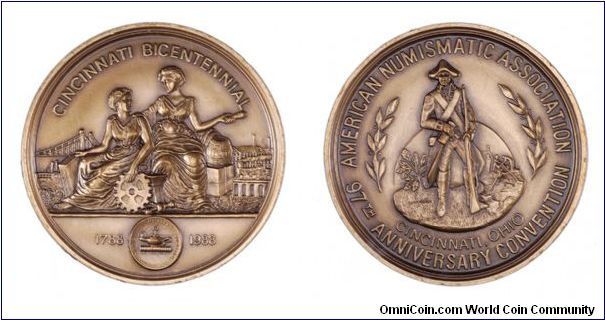
1999 Chicago Annual Convention (one of my favorite designs).
Mintage: 200 bronze and silver sets (reeded edges).
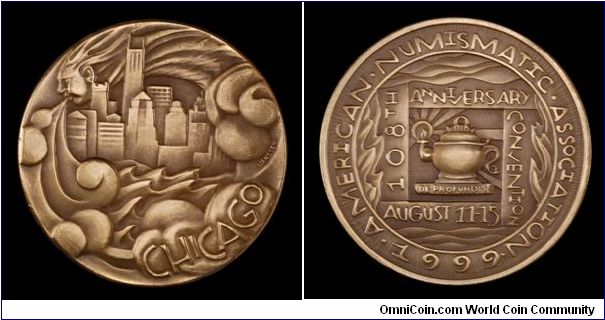
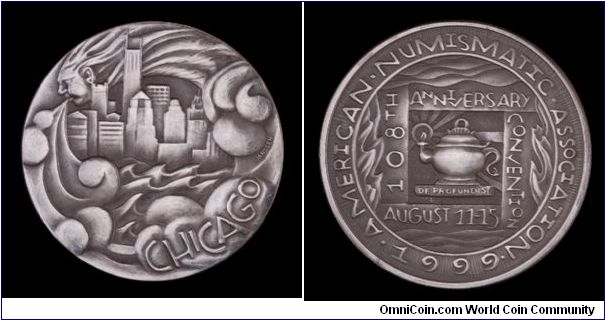
2002 New York, 57 mm bronze.
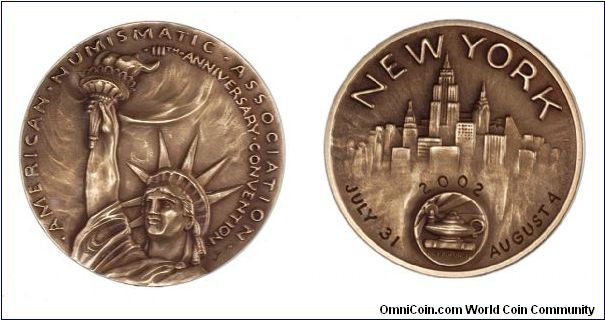
-
Three convention badges in chronological order:
1951 Phoenix badge.
Mintage: 450, no official medal.
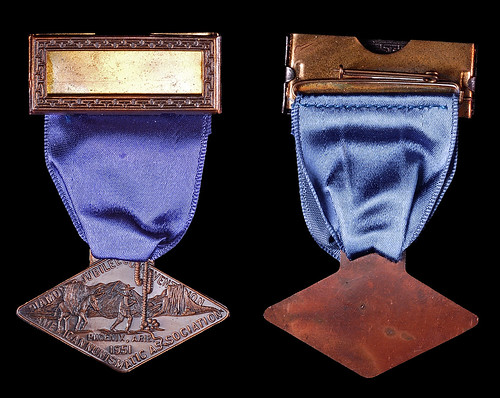
1962 ANA/CNA Detroit Convention badge. Merged emblems of the United States and Canada.
Mintage 2,500.
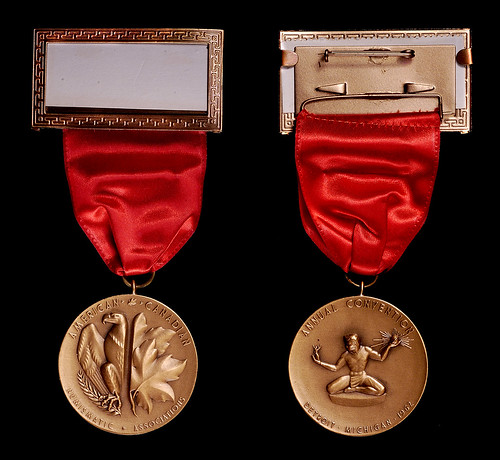
1966 Chicago, 75th Anniversary Convention
Mintage: 4,000

-
Pond 8
Bronze, 32 mm
Cammall Badge Co.
3000 Struck
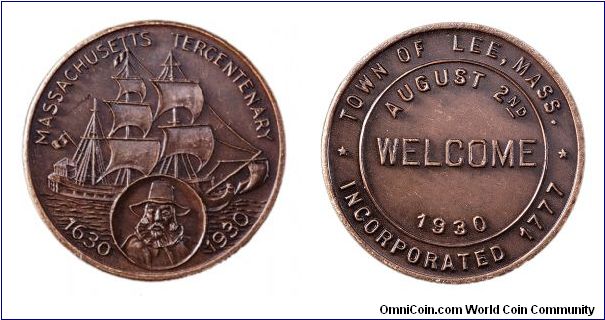
-
A second coin box, this one a short stack and rarer than the one pictured above.

The top of the box is a version of the California state seal. The bottom (on the right) is the same as the top of the tall stack pictured earlier in this thread. The box has been harshly polished over the years, but all material from the 1894 exposition is rare.
Larger image.
-
Congratulations.
-
Pond 2
Bronze, 54 x 85 mm
Robbins Co.
1000 Struck, 1 gold

Governor's presentation medal, also struck by Robbins Co., Attleboro, MA.
Obverse: Shield centered, topped by torch with a bust of GOV. JOHN WINTHROP. To the left a standing Indian with bow, to the right three ships standing in shore. Below, MASSACHUSETTS BAY COLONY / 1630 TERCENTENARY 1930.
Reverse: The original state house and the modern state house with the arms of Massachusetts below to the left. The inscription reads, PRESENTED BY HIS EXCELLENCY FRANK G. ALLEN / GOVERNOR OF THE COMMONWEALTH OF MASSACHUSETTS IN / OBSERVANCE OF THE THREE HUNDREDTH ANNIVERSARY / OF THE FOUNDING OF THE MASSACHUSETTS BAY COLONY / AND THE ESTABLISHMENTOF CIVIL GOVERNMENT THROUGH / THE TRANSFER OF THE ROYAL CHARTER FROM ENGLAND.
Larger image.
-
Pond 28
Silvered white metal, 28 mm
Robbins Co.
10,000 Struck
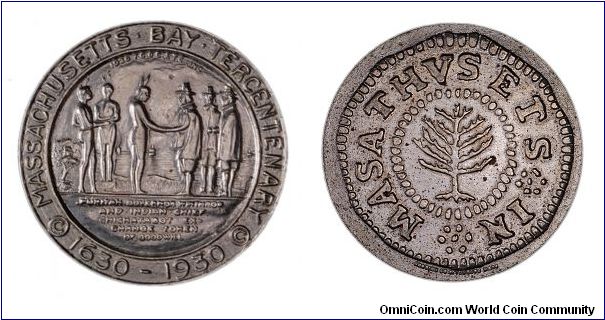
The official medal of the Tercentenary Conference of City and Town Committees, design adopted on May 8, 1930. The intent was for the medal to be produced in massachusetts and be widely available. While the general design was used for medals struck by Whitehead and Hoag, the Conference medal was struck by Robbins Co., a Massachusetts firm.
Obv: View of Indians greeting Pilgrims with the legend, PURITAN GOVERNOR WINTHROP / AND INDIAN CHIEF / CHICKATABOT EX- / CHANGE TOKEN / OF GOOD WILL. Above, in microscopic lettering, is the notation, 1930 T.C.O.C. & T. C. INC. The outer ring reads, MASSACHUSETTS BAR TERCENTENARY / 1630 -1930.
REv: Copy of a Pine Tree Shilling with the microscopic mark, ROBBINS CO. ATTLEBORO, MASS.
And the medal adapted as an award medal.
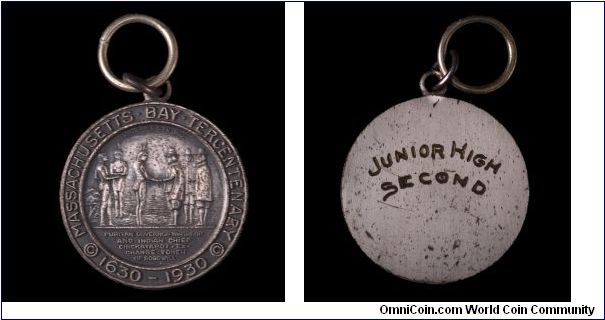
-
Pond 7
Gilt Bronze, 32 mm
Cammall Badge Co.
5000 Struck
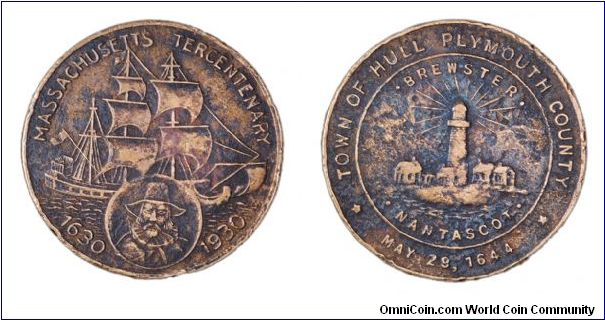
No longer gilt, this medal appears as if it were buried or suffered some other similar fate.
Obv: As earlier examples.
Rev: Lighthouse with out buildings, BREWSTER / NANASCOT. Outer ring reads, TOWN OF HULL, PLYMOUTH COUNTY / MAY 29, 1644.
Nanascot refers to the Indian district that preceded European occupation.
Acquired a better specimen:
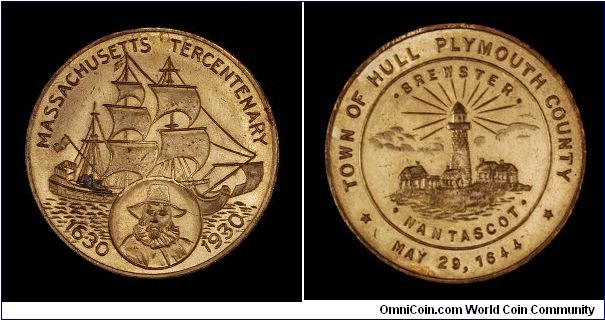
-
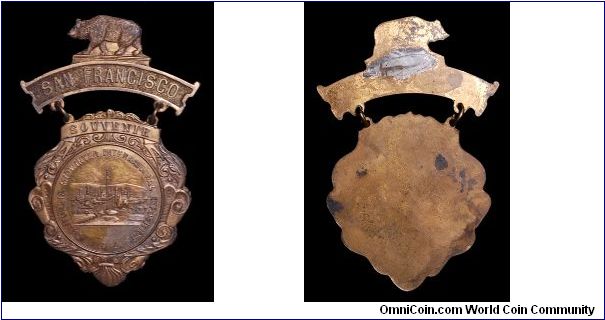
The pin is missing, but the badge is still a neat item.
-
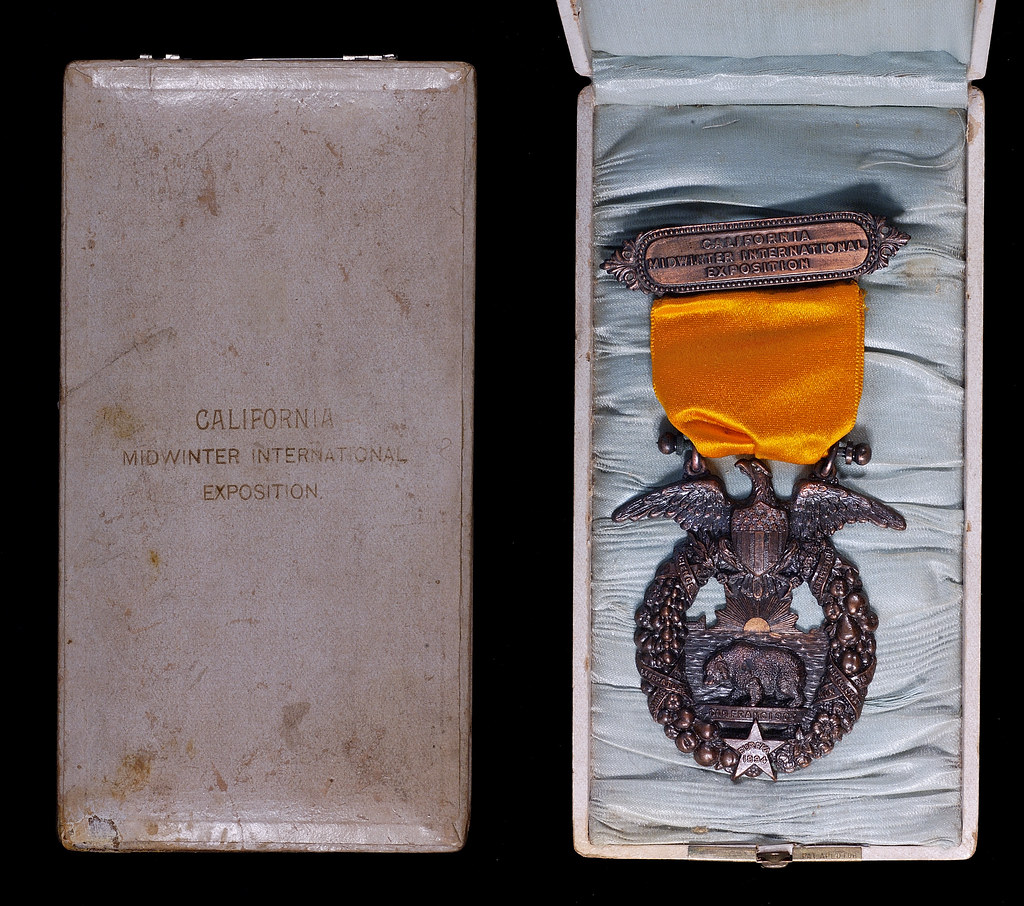
Not long after acquiring the base of a medal of award and attempting a potential reconstruction from the base and a photograph, I managed to acquire an example in its original presentation box.
Compare the near chocolate bronze patina on the complete medal issued here and the gilt appearance on the base pictured above. The reverse of both medals appears to be the same (blank and apparently gilt or shiny brass). Perhaps gold and bronze medals? I have no evidence one way or the other.
-
-
Pond 26
Tumbled nickel finish, 30 mm
Whitehead & Hoag Co.
22,000 struck
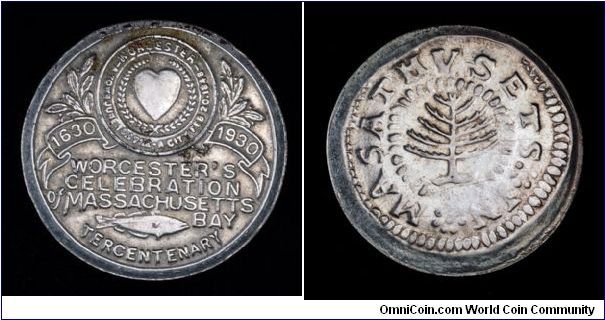
Obverse: The seal of Worcester, WORCESTER'S / CELEBRATION / OF MASSACHUSETTS / BAY / TERCENTENARY.
Reverse: Pine Tree shilling copy.
Pond notes these were said to be widely distributed to school children.
-
Pond 15
White Metal with oxidized silver finish, 30 mm.
Whitehead and Hoag Co.
20,000 struck
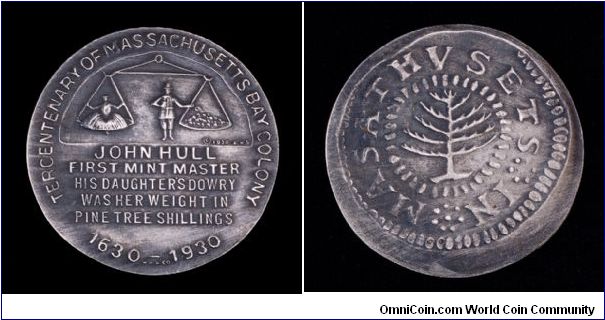
Obverse: Image of a balance beam, standing man, girl on one scale tray, pile of coins on the other, microscopic copyright 1930 BHS. Outer ring reads, TERCENTENARY OF MASSACHUSETTS BAY COLONY / 1630 - 1930. The legend reads, JOHN HULL / FIRST MINT MASTER / HIS DAUGHTER'S DOWRY / WAS HER WEIGHT IN / PINE TREE SHILLINGS. Microscopic mark, W & H CO along the rim.
Reverse: Reproduction of the Pine Tree schilling.
Pond believes these were the first souvenirs struck for the tercentenary. The Bourne Historical Society sold the medals to raise funds for the Trading Post Endowment Fund. The original Plymouth Colony Aptucxet Trading Post was built in 1627. The historical society maintained a replica of the trading post.
As legend goes, John Hull paid his daughter's dowry with her weight in the Pine Tree shillings that he produced in the early mint.
The Puritan medal with codfish reverse first attracted me to this series, but it was the Pine Tree shilling medals that convinced me to concentrate on the topic.
-
Pond 12
Gilt Bronze, 32 mm
Whitehead & Hoag Co.
Mass Produced
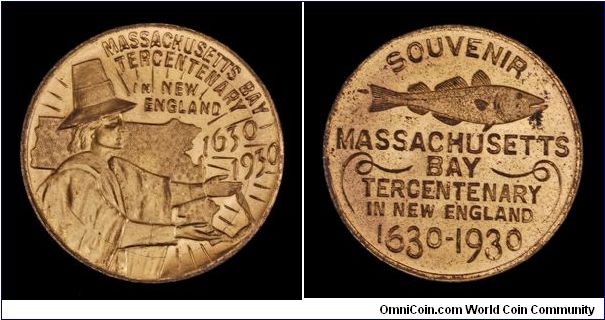
Pond 13
Gilt Bronze, 32 mm
Whitehead & Hoag Co.
Mass Produced
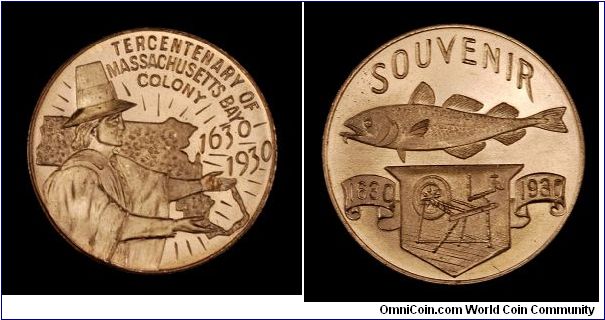
Two generic medals sold throughout Massachusetts during 1930. These are the two most common medals encountered.
Common obverse: Puritan male facing right with a map of Massachusetts behind. MASSACHUSETTS BAY / TERCENTENARY / IN NEW / ENGLAND / 1630 / 1930.
First Reverse: Codfish facing right with the legend: SOUVENIR / MASSACHUSETTS / BAY / TERCENTENARY / IN NEW ENGLAND / 1630 - 1930.
Second Reverse: Codfish facing right with a spinning wheel in a shield below. SOUVENIR 1630 1930.
On the first medal obverse, note the circular die-crack that extends about three quarters of the way around the medal.
-
I really like the rectangular medal, very well designed and manufactured.
It feels good in hand as well. It is 5 mm thick and weighs about 8 ounces, so it has a nice heft. I have one other of this size that I am awaiting delivery. Its made by the same company and I believe it is as nice from the photographs.
-
Pond 5
Bronze, 32 mm
Cammall Badge Co.
3500 struck
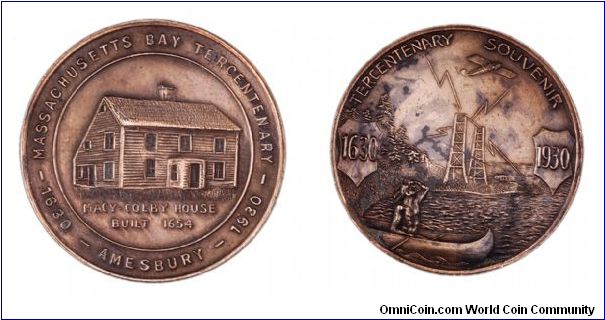
Obverse: Settler's house, MACY - COLBY HOUSE / BUILT 1654. The surround inscription: MASSACHUSETTS BAY TERCENTENARY / 1630 AMESBURY 1930.
Reverse: The Indian in canoe reverse from the generic state medal.
The Macy - Colby house was the homestead of Thomas Macy whose flight to Nantuket is described in Whittier's poem, The Exiles. He sold it to Anthony Colby and his descendant, Moses Colby, sold it to the Bartlett Cemetary Association. In 1930, it housed a chapter of the Daughters of the American Revolution.
-
Pond 3
Gilt Bronze, 33 mm
Cammall Badge Co.
Mass Produced
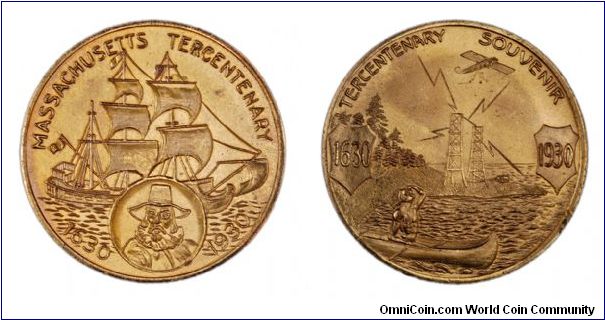
Pond 4
Gilt Bronze, 32 mm
Cammall Badge Co.
Mass Produced
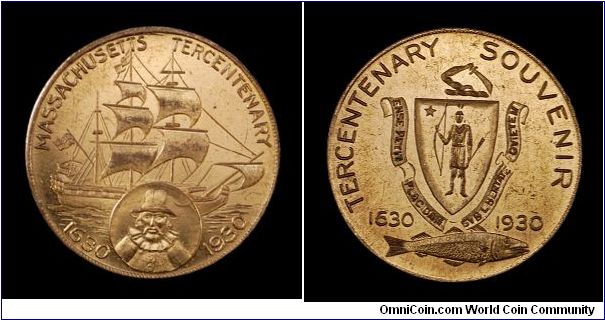
Two generic souvenir medals sold through out the state.
Common obverse: A sailing ship, the Arbella, with the head of a Puritan below (Gov. Winthrop). MASSACHUSETTS TERCENTENARY / 1630 - 1930.
First reverse: Indian in a canoe gazing at radio towers and an airplane. TERCENETENARY SOUVENIR / 1630 - 1930.
Second reverse: A representation of the Massacusetts state seal with a codfish below. TERCENTENARY SOUVENIR / 1630 - 1930.
Pond 3 used for an employee medal for Lever Brothers. A day at an amusement park outside Boston/Cambridge.
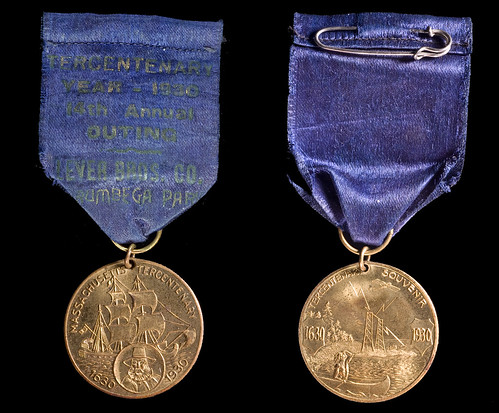
-
With the price of gas and the cost of coins from Europe when paying with dollars, I've started two new topics to occupy my collecting fever.
The Massachusetts Bay Tercentenary was celebrated in 1930 across the state with a variety of exonumia. The organizers hoped for a commemorative half dollar, but I suspect the Pilgrim half issued ten years earlier made that goal a long shot. At the end of 1930, Shepard Pond collected the various medals and tokens issued over the year to form a representative collection viewed as the state commission closed its books. Pond went on to publish a list of the items in the June 1931 Numismatist followed by updates over the next two years. The ANA brought the various articles together into a reprint. I am using Pond as my guide for collecting the items, although I am ruling out some athletic badges and an encased cent. I will post the items here as I build the collection.
Pond 1
68 mm x 90 mm
Bronze (also plated in gold and silver)
Struck by Robbins Co., Attleboro, MA
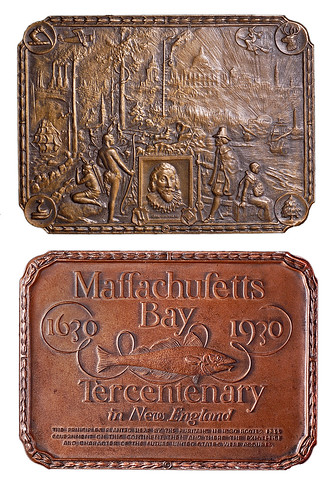
I'm showing as my obverse what Pond calls the reverse of the medal. I know one could debate the issue, but I think of the image side as the obverse and the text side as the reverse in this case. The tercentenary final report described the medal as I do.
Obverse: A symbolic scene of the historic development of New England. First Bay Colony Governor John Winthrop appears in the bottom center with the charter and great book below.. To the left is an Indian family with a child. A stagecoach winds its way along a road, with a sailing ship on the sea in the distance. In the far distance, one can see smoke stacks, a city skyline, and an airplane. To the right is a Puritan family with child and ships sailing upriver towards the woodland and the setting sun. Bunker Hill Monument can just be seen. A witch flys across the full moon. The emblems in the four corners are the Liberty Tree, the don't-tread-on-me rattlesnake, the arm and sword from the state seal, and the ancient notary seal of a stag's head.
Reverse: The emblem adopted by the citizen's organizations sponsoring the tercentenary showing the codfish. The inscription reads THE PRINCIPLES PLANTED HERE BY THE PURITANS IN 1630 ROOTED FREE GOVERNMENT ON THIS CONTINENT. THEN AND THERE THE EXISTENCE AND CHARACTER OF THE FUTURE UNITED STATES WERE ASSURED.
The edge is stamped ROBBINS CO. / ATTLEBORO. REG. U.S. / PAT. OFF
The medal sold for $5 in rose gold, $4 in silver, and $3 in bronze. It came with a booklet which I have not seen.
A larger image.
-
Added another just published work as well:
Striking Change: The Great Artistic Collaboration of Theodore Roosevelt and Augustus Saint-Gaudens. By Michael F. Moran, Whitman Press, 2008.
I haven't read it as yet, but Moran's article on the San Francisco earthquake and the US Mint published in the Numismatist a couple of years ago was excellent. It was well researched and well written.
-
My copy of the deluxe edition of the 2nd edition of Hibler and Kappen's So-Called Dollars arrived yesterday. Hardbound and full color unlike the trade edition (paper bound, black-and-white). Five of my photographs of my medals are included and I am listed in the acknowledgments. I was asked to contribute photographs based on my Coin People posts and I was happy to do so. Needless to say, I am very pleased with the book!

-
-
I really hesitate to throw my example into the mix, but:
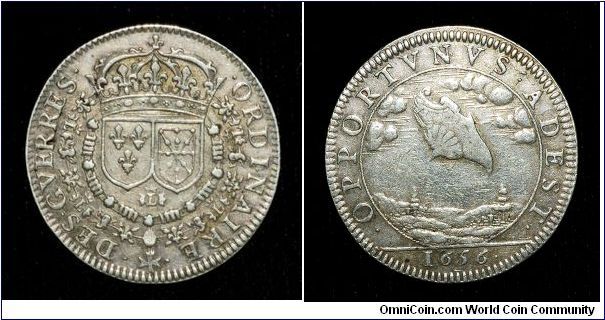
I don't have much use for more testicles than I already have, but money is always useful. However, my jeton is not for sale today. The image is definitely a "celestial" shield. I'm not sure I could easily relocate a cgb image of one such shield leaning against a wall with some weapons illustrated on a spectacular jeton. It is in one of their auctions (not the jeton catalogs) and it went for something between $500 and $1000 if I remember right. It is a spectacular piece. I will post a link if I stumble across it again.
The opportune time refers to the battle of Troy when the gods threw down a "celestial shield" at an opportune time. That is a much too short reference to a much longer story. In any event, French symbolism drew heavily on the legends of Troy, etc. in the 1600s.
-
And, I like the bust on your new acquisition.


YeOldeCollector's Olde Purchases
in My New Purchases
Posted
There are some days when I wish I had never parted with my early Nowegian penny (ca. 900) and two bractates, but I did all too many years ago.
Lovely coins and wonderful additions to your collection..